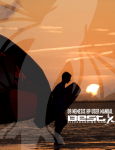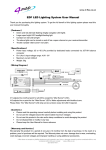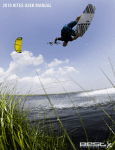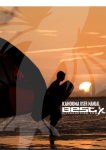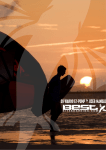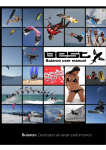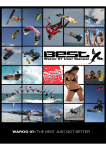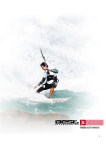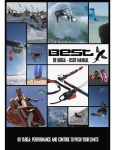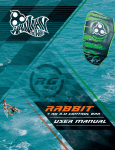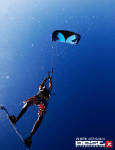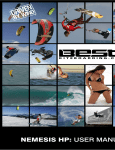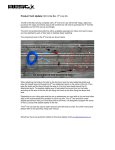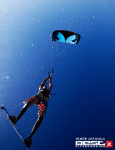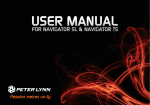Download best kiteboarding user manual
Transcript
1 BEST KITEBOARDING USER MANUAL Thank you for purchasing a Best kite. Please read this manual carefully and in its entirety before using your new Best kite. WARNING Kiteboarding/kitesurfing/snowkiting are extreme sports. They have numerous inherent risks and dangers, and pose substantial risk of cuts, scrapes, bruises, broken bones, loss of limbs, loss of vision, paralysis, and other serious, permanent and disabling injuries and death to the rider and others. Some of the sources of these risks include but are not limited to: • • • • • • • • Being lifted by the kite and then dropped or slammed into the ground, snow, trees, rocks, buildings, piers, jetties and/or other structures or surfaces. Being dropped or slammed into other people and/or property. Contact with kite lines under tension, and/or watercraft. Drowning. Underwater conditions and/or objects such as sharp shells, broken glass, sand bars, shoals, reefs, oyster beds, and/or concrete. Contact with sea life such as sting rays, sharks, sea turtles, jelly fish, etc. Weather conditions and/or changes in weather conditions such as increasing or decreasing wind, waves, updrafts, lightning and/or water spouts. Equipment performance. Kiteboarding is a new sport. Kiteboarding equipment and safety gear are NOT 100% reliable. Safety designs and features are often new and unproven. Kites may behave unfavorably and unpredictably. Lines can twist, tangle, or break, resulting in serious injury and/or loss of control of the kite. When using this product, you are responsible for your own safety and the safety of others around you. Never use this product as a flying device. Never touch flying lines when the kite is in use. RELEASE OF LIABILITY AND ASSUMPTION OF RISK DO NOT USE THIS PRODUCT UNLESS YOU AGREE WITH THE FOLLOWING TERMS AND CONDITIONS: Before using this product, the purchaser/user has carefully reviewed, understood and agrees to comply with the terms of this User Manual. Use of this product and any of its components involves certain inherent risks, dangers and hazards, which can result in serious personal injury or death. The purchaser/user of this product understands that the seller is not responsible for any damage to property or injury caused by negligent operation of this product by the purchaser/user, and the purchaser/user releases the seller from all such liability. In the event of your death or incapacity, this Agreement shall be effective and binding upon your heirs, next of kin, executors, administrators, assigns and representatives. The purchaser/user of this product expressly assumes the risk of any and all bodily injury, death and/or liability which may result from the purchaser or user’s participation in kiteboarding. The purchaser/user agrees to hold Ride Best, LLC harmless from any and all liability, and waive and release any and all claims or potential claims against Ride Best, LLC and any of its respective agents, affiliates, subsidiaries, employees, instructors, officers, directors, shareholders, suppliers and manufacturers in the event of any such bodily injury or death which may result from the purchase and/or use of Ride Best LLC (d/b/a Best Kiteboarding, LLC) products. © 2008 RIDE BEST, LLC, d/b/a BEST KITEBOARDING, LLC 2 Waroo: Freeride SLE Kite Introduction: Best Kiteboarding would like to thank you for choosing the new 2009 Waroo. We guarantee this and all of our products to be free from defects in materials and workmanship. All Best products are covered by our Fair and Reasonable Timeframe warranty, which offers extended coverage beyond that provided by other brands. Best Kiteboarding has a dedicated, year-round R&D team comprised of our world-class technical staff and pro-team riders. We never stop testing and we never stop improving our products. The standard against which all other free-ride kites are judged, the ‘09 Waroo doesn’t just blur the lines between new school and old school, wakestyle and freestyle: it erases them. The Waroo’s huge depower, fast turning and easy handling help riders of all skill levels to progress faster, further, and simply, have more fun kiteboarding. The ‘09 Waroo comes with a revised VP2 bridle for perfect stability and ABC Custom Tuning for confidence-inspiring versatility and ease of use. Our legendary Surf Tough build quality and original Canopy Framing ensure your Waroo can withstand any abuse you throw at it. For freeriding, the Waroo continues to offer the perfect balance of ease of use and accessible performance. If your riding style includes a little bit of everything, then the Waroo is the perfect kite for the way you ride. Waroo: Do anything, Ride everywhere. 3 Waroo: Kite package Your Waroo kite is delivered complete with the following items: • Over–the-shoulder carry bag • High-volume, dual-action pump with alloy shaft • Bladder repair kit • 2 replacement TE battens • This user manual on CD Waroo: Performance features and kite set up When unpacking your Waroo for the first time, we recommend that you take some time to familiarize yourself with the product and design features that make your kite unique. This will help you set up the kite correctly the first time, ensuring you gain the maximum potential from its high-performance design. VP2 Front Bridle Pulley System: Best Kiteboarding's VP2 bridle system provides a 2:1 depower / bar travel ratio. This allows the Waroo to provide full depower from reduced bar travel. Unlike older SLE designs that rely on bar mounted pulleys there is no increased bar pressure associated with the VP2 design. VP2 is unique in that in addition to giving twice as much depower it also optimizes load distribution between the wingtips and the center of the LE for a more rigid and stable kite, ensuring that AOA changes have no effect on the stability of the kite. The upper canopy section of the VP2 bridle highlighted in RED left includes an additional pulley that improves the relaunchability of the Waroo by allowing the kite to slide under its bridle during relaunch. When unpacking your kite for the first time, correctly lay out the front bridle as shown in the image on the left. For maximum performance and correct depower function, it is important that the front bridle is free from twists and knots. When correctly laid out, the VP2 section of your front bridle should look exactly like the image on the left. Any twists in the bridle can be removed by counter-twisting the lines where they connect to the front flying lines. See last page for more details. ABC Custom Tune Options: ABC custom tune gives you the control to rig your kite to suit your personal riding style preference and wind conditions. With riders of all skill levels choosing the Waroo as their go-to freeride kite, we have increased the range of adjustability provided by the ABC Custom Tune feature this season at both ends of the scale. Canopy Framing Technology: Crashing your kite is a fact of life. The Waroo is the only freeride kite designed with the ultimate reinforcement system, Canopy Framing Technology. The entire perimeter of each canopy panel on the Waroo is supported with a continuously-curved reinforcement 4 zone. During a crash, this isolates the canopy from impact loads, delivering durability based on sound engineering. CFT is a unique approach to the tasks of distributing shock loads and effective transfer of TE tension across the canopy of your kite. With CFT, a lightweight but incredibly strong ‘buffer zone’ is stitched into the canopy sections and between the airframe and canopy. Due to the unique continuous curved shape of CFT, impact energy is harmlessly circulated around the kite until completely dissipated. Load Flex LE Seam: The 09 Waroo LE seam is triple stitched with a full length webbing tape closure and internally shielded by mark cloth tape. The Load Flex seam design provides additional support to the leading edge, helping to provide maximum strength and stability to your kite. 3D Kevlar Airframe: All LE strut joints are laser cut, shaped and Kevlar tape reinforced. There is no better way to connect the leading edge to the struts. Our construction yields the strongest and lightest airframe possible which translates into added performance and maximum durability. Dacron Wingtip Panels: Multi-layer Dacron wingtip panels distribute turning forces for unmatched responsiveness and enable selflaunching without risk of damage. Increased surface area at the wingtips gives greater turning agility, while our curved wingtip profile improves aerodynamics and eliminates vortex-induced drag. Kevlar Wingtip and LE Patches: However and wherever you ride, your kite will come into contact with the ground at some point. Our Kevlar reinforced LE and wingtip patches give maximum abrasion resistance to protect your kite, even when self-launching in less than ideal situations. Woven Spectra Serviceable Pulley Lines: High strength wear-resistant 4mm braided abrasion-resistant pulley lines with precision Ronstan pulleys provide friction-free depower action. Combined with our new VP2 bridle design, they deliver unbelievable depower and wind range. TE Battens: Precision-tolerance fibreglass battens support the trailing edge canopy section and smoothes the airflow over the trailing edge. Improved aerodynamics ensure faster turning and silent maneuvering, while our smooth pocketed mark-cloth construction delivers outrageous durability. CFT Reinforced Trailing Edge: Like all kites in our ‘08 range, the Waroo benefits from our exclusive CFT reinforced trailing edge, which provides razor-sharp turning response and unmatched durability compared to all other trailing edge construction techniques. 5 Surf-Tough Build Quality: Our unique Canopy Framing Technology, LE Load Flex seam, fully taped canopy and 3D Kevlar Airframe come together to deliver the most proven and trusted kite construction package in the industry. A kite purchase is a considerable investment; with the legendary Best Kiteboarding build quality and warranty, buying a Waroo will be the smartest investment you will make this year. Waroo Performance Characteristics: Setup Options and Pre-flight checks: The Waroo is shipped with all bridle lines secured to the center strut valve-retaining Velcro. When you receive your kite, unroll your Waroo and remove the foam valve protectors from the strut and LE bladders. Next, detach the bridle lines from their traveling position on the center strut and separate the bridles into left and right. Front Lines: The front attachments are comprised of a leading edge bridle that terminates on both sides with a closed loop (larks head) and replaceable center section that the VP2 pulleys travel on. Should advanced signs of wear show on either the pulleys or bridle after extended use, contact your nearest dealer for replacement parts. When unpacking your kite for the first time, correctly lay out the front bridle as shown below. For maximum performance and correct depower function, it is important that the front bridle is free from twists and knots. When correctly laid out, the VP2 section of your front bridle should look exactly as the image on the bottom right. Any twists in the bridle can be removed by counter-twisting the lines where they connect to the front flying lines. Any twists should be removed before attaching the flying lines. Only attach your front flying lines to the knotted pigtail attached to the bottom pulley. 6 All pulleys run on abrasion-resistant woven spectra insert lines. This line is chosen specifically for its flexibility and abrasion resistance. Due to the use of moving parts, it is recommended that you check the smooth operation of the pulleys before each flight. The Spectra insert lines will need replacing from time to time according to how often you ride and in what conditions. We recommend that you consider changing your pulley insert lines once a season. Any damage on the main bridle should be replaced immediately. Rear Line Rigging: A-B-C Custom Tune The rear flying-line attachments on the Waroo are comprised of two lines that join to form a short ‘V’ shaped bridle. The rear flying lines attach beneath this ‘V’ section to one of the four supplied knots. We recommend that you start on the bottom knot and work your way up until the find the knot which best suits your riding style. The wingtips of the Waroo have three attachment points, A-B-C. Moving the rear bridle between the A-BC attachment points allows you to vary the turning speed, turning circle, depower rate and power delivery of the kite to suit your preferred riding style. ABC Custom Tune set-up options are detailed below. A-A: This setting has the tightest and fastest pivot turning style while delivering the lightest bar pressure. Riders will find this particularly suited to killing the power when big wave surfing and for extracting the maximum control for big air and huge hang time. A-B: This setting gives light bar pressure with a turning feel midway between traction and pivot turning. Turning speed remains very fast on this setting. The A-B setting gives the most precise handling and crisp bar feedback. We recommend this as the stock setting for any rider new to the kite. A-C: This is the mid-position set-up. A-C splits the ‘V’ bridle between the front-most and rear-most attachment points. A-C offers an excellent combination of turning speed, depower and bar feedback that is particularly suited to unhooked riding and for extracting maximum control in high winds. Bar pressure is similar to the Yarga in this set-up; turning speed remains fast, making this the ideal freestyle/competition setting. B-C: (not shown). Recommended for riders who want very heavy bar pressure and the slowest turning kite; this setting is useful for old school no-whip wakestyle tricks. Swapping the rear V lines across the A-B-C connection points increases and decreases the effective length of the rear lines. A-A increases the rear line length by one knot. To compensate, attach one knot closer to the kite. A-B is the recommended stock setting. No need to use a different knot for this position. A-C shortens the rear line length by one knot. To compensate, attach the rear lines one knot further away from the kite. 7 Pre-flight checks: The rider should perform a thorough inspection of the kite, each time the kite is set up, and prior to launching, to ensure that the kite has sustained no damage during use. Any damage should be repaired by a professional kite or sail loft to ensure continued safety and usability. It is worthwhile to inspect all flying line attachments, pigtails, pulleys and pulley insert lines before each flight. Damage to any of these areas may render your kite unsafe to fly. Self-launching the Waroo: The Waroo can be self-launched from the beach like any other SLE kite. Although the Waroo has line deflectors on the strut ends to ensure that flying lines do not become entangled in the airframe, when self launching, make sure that the front bridles (highlighted RED) are placed clear of the wingtips of the kite prior to sanding down the wingtip. Position your fully inflated kite, with the lines attached, at one edge of the wind window. Your flying lines should run directly across the wind to your bar, which is placed at the opposite edge of the wind window. st nd Placing sand on the inside of the kite behind the 1 strut towards the 2 strut helps to keep the kite flat to the wind until the wingtip has been folded over and secured with more sand. Fold the wingtip over on the leading edge, and sand down the folded wingtip. Before going back to your bar to launch, wait at the kite for a while to ensure you have placed enough sand on the kite to hold it down. Return to your bar, which should be positioned across the wind, on the opposite side of the wind window from your kite. Hook into the chickenloop, and take a second to check your lines visually one last time, making sure that the center lines are connected to the front bridles, the outside lines are connected to the back bridles, and that the front and back lines are not crossed over each other. With the bar firmly in your grasp and the bar positioned at 50% depower position, pull the top of the bar towards you and step backwards. Pulling the bar back towards you and stepping backwards will flick the sand off the wingtip, releasing the kite and allowing it to self launch. If it is possible to have someone experienced assist in the launch, this is always the preferred method. Assisted Landing of the Kite: When landing your kite with an assistant, simply fly the kite to the edge of the window and down to ground level slowly. Have your assistant take hold of the kite firmly in the middle of the leading edge. 8 Both you and your assistant should then walk towards each other to remove all tension from the flying lines. Your assistant can either lay the kite down and sand the upper canopy, or hold the kite until you are unhooked from the bar and safely able to take over the kite Self Landing the Waroo: Front line OSR To land your Waroo using the front-line OSR handles, depower the kite fully using the trim strap, undo the bypass/handlepass leash carabineer on the chickenloop, then reach up and take hold of one of the front line OSR handles. When grabbing a front line OSR handle always ensure that the depower strap swivel is un-spun and that the front lines are untwisted. With the OSR handle firmly in your hand reach down and unhook from the kite, dropping the bar. Once released onto a front-line OSR handle, the kite will fall to the ground in the downwind position. Secure the grab handle to a solid object and work your way down the flying line to secure the kite. Self Landing the Waroo: Rear line OSR We always recommend that riders use the front line handles to land their kite if unassisted. The rear line handles are primarily intended as back up safeties should you be unlucky enough to break a front line or be unable to untangle your front flying lines. You must detach the bypass/handlepass leash before attempting to land the kite via the rear line OSR handles. Fly your kite to the side of the window leaving the kite at an angle of about fifteen degrees to the ground, this equates to the lowest wingtip being about 5m from the ground. With the kite at the edge of the window and the retaining Velcro on the OSR handle already loosened, sheet-out, reach up and grab the lower of the two OSR handles. With the webbing loop firmly in your grasp, unhook while holding onto the webbing handle and proceed to drop the bar. The Waroo will fly slightly to the edge of the window, and then loop under itself, coming to rest on the beach in the dead downwind position, facing into the wind with the leading edge facing up. 9 This method is only recommended if you have more than two line-lengths of downwind space and it is impractical to land your kite using the front line OSR handles. Water Relaunching the Waroo: The Waroo has ‘built-in’ relaunch capability due to the curved shape of the wingtips and the geometry of the VP2 bridle. With the kite’s leading edge down in the water, simply depower the kite via the trim strap, then pull and hold either of the back lines to start the relaunch process. The kite will taxi across the wind window, eventually rotate upwards into an upright position, and then await relaunch, which is initiated by pulling back on the side of the bar that corresponds to the uppermost wingtip. As the kite is relaunching off the water, be careful not to pull all the way in on the bar, which could oversheet the kite and cause it to fall backwards into the water. Instead, as the kite begins to lift from the water, push out on the bar a little and avoid oversheeting. In lighter winds, it may be beneficial to use your board to create extra resistance to the pull of the kite, to enable faster relaunch, and to speed the kite taking an upright position at the edge of the wind window. Once in this position, simply adjust the bar and steer the kite, launching it upwards. Hot launching: With the kite resting on its trailing edge in the water, with its weight partly supported by the struts, it is possible that the kite may accidentally ‘hot launch’ at some point downwind of you in the power zone. As soon as the kite powers up, it is imperative that you push out on the bar and sheet out the kite, for frontline load only (otherwise you’ll be taken for a ride). The rear lines must not have any tension until the kite is safely in the neutral zone, which, in this case would be overhead at the zenith. Reverse launching: When the kite is directly downwind of you, with LE resting on the (with the wingtips closer to you and the c-shaped center of the kite farthest away from you), you can create a reverse draft using the rear lines on the trailing edge, which causes the kite to hover up backwards. If both rear lines are pulled with even tension, the kite will hover up, evenly balanced. If one rear line is released a few inches, the kite will spin around in the opposite direction and start to redirect. In this case be prepared to flip the bar and sheet-out the kite to reduce powering up the kite in a downwind position, and crashing it back into the water. Both of these are advanced techniques and only recommended for experienced riders. Wind Ranges: The suggested wind range chart is to be used as a guide. Always know your limits, and when in doubt, rig a smaller kite, if possible. Wind speeds may vary according to where they are taken. Always take a wind reading more than 100m past the nearest upwind object to get an accurate maximum reading. If flying in the mountains, 10 always take a wind reading towards the highest point of land as wind accelerates up hill. The wind ranges given overleaf are based on a 75kg rider and kitesurfing usage. For snowkiting and landboarding the wind ranges will vary according to snow and surface conditions but will be 3-5 knots lower for bottom end and 4-6 knots lower for top end. The lower wind range for any kite can be increased by the use of a larger surface area or volume board. To estimate usable wind range for different weights, assume that an additional 10kg/22lbs will cost you 3 knots of low end and improve your high-end by 3-5 knots. On a practical note, however, please realize that no amount of calculation and known variables can make up for the fact that you simply need a certain amount of wind to fly a kite, regardless of kite size in relation to all other factors. Best Kiteboarding recommend than no rider ever attempts to kite in wind speeds exceeding 35 knots. If you cannot keep your kite stable at wind speeds approaching the upper stated limits for each size kite, then please do not attempt to exceed your skill level. Waroo FAQ: How should I care for my Waroo? Inflate and deflate your kite with care. Follow proper inflation techniques and pack your kite when it is completely deflated and dry. Do not pack wet and leave it for any length of time. Dye transfer may take place on a kite that is packed away wet, and is not covered under warranty. Do not leave the kite inflated and sitting in the wind unused for long periods of time, as this accelerates wear to the canopy cloth. Inspect the kite periodically for small holes or tears and patch when detected to eliminate costly repairs. Can I use a bar from other kites on the Waroo? Yes, however, certain precautions need to be taken into consideration when using other bars. It is best to seek technical assistance before rigging a ‘non-Best bar’ to the kite. The Waroo is designed to work perfectly with the 08/09 Best bar. Its extended travel allows for complete depower of the kite, which is key to the improved safety of the Waroo over a ‘C’ shaped kite. How hard should I pump my Waroo kite? We recommend 9-10-PSI for the HP: smaller kites require slightly more inflation +.5 PSI and larger kites up to .5 PSI less. An under-inflated kite will be problematic through the flight cycle and when re-launching. Some riders have noted that in adverse wind conditions, inflating the kite slightly above the recommended PSI has delivered further benefits in improved stability. This is particularly noticeable in the snow where the cold air temperature may lead to a decrease in internal air pressure over time. Due to the hugely increased risk of impact damage when flying on land, we recommend that landboarders and snowkiters do not exceed the recommended inflation pressure of 10 PSI. Do not store your Waroo with inflated struts inside a vehicle during the summer, as in-car temperatures can rise rapidly leading to a catastrophic increase in strut pressure. We recommend that when storing the kite for any period of time, all the valve plugs be removed from the valves. Also, do not leave the sticks on the struts inside of the valves when storing the kite, as this could rupture the membrane valves. What safety systems are built into the Waroo? A Waroo flown with any 08/09 Best Bar has multiple redundant safety systems. First and foremost, pushing the bar away and forcing it to slide up to the trim strap will depower the kite to its depower limit. Unhooking the kite and dropping the bar when attached to the bypass leash ring will result in the same maximum depower state being achieved. Both rear and front flying lines are equipped with OSR handles on the 08 and 09 Best Bar. These can be used to completely flag the kite out to a powerless position. A suitable leash extension could also be clipped to the webbing handles for use on the water. Note: clip only to the webbing handle; never clip directly into the stainless rings. Always ensure that the retaining Velcro is unfastened before clipping into webbing handles. Failure to do so may compromise the function of the safety system. 11 How do I rig my Waroo, and what attachment knots should I use? The Waroo comes with four knots already tied on the bottom of the rear flying-line attachment ‘V’ bridle. The Waroo is designed to work best for riders of average weight when the flying lines are attached to the st nd 1 or 2 knot from the bottom on the rear bridle and the rear bridle is attached to the kite in the AB position. (Refer to earlier section on A-B-C set-up). We recommend that you start with the bottom knot and work your way up until you find the knot that works best for you. Heavier riders, and riders looking to gain more power from their kites, may choose to use a knot closer to the kites. We recommend that you experiment to find your preferred setting. When attaching for the first time, please use the bottom knot on the bridle. If the kite’s handling and turning is sluggish, then re-attach to the next knot up. Repeat this procedure until you have found the perfect knot position for your arm reach and your preferred riding style. Please ensure that you do not attach the lines too close to the kite and so that it is forced to backstall when you pull the bar in. For maximum safety and efficiency, have a helper there to help launch and land your kite. When the kite is trimmed correctly, you should be comfortable enough to steer the kite and still have enough reach left to depower the kite by pushing the bar away from you. As an additional passive depower adjustment, the trim strap allows further depowering on the fly. If you intend on riding unhooked for performing tricks it is important that you trim your kite so it does not back stall when unhooked. Always use the bottom knot. To check this once you think you have found your preferred rear knot setting, unhook the chicken loop from your spreader bar and fly the kite overhead. If the kite sits directly above you without backing down into the window, then you have the perfect trim. If you find the kites wants to back down towards the beach, you have too much rear line tension and the kite is oversheeted. To fix this, simply pull down on the depower strap in small increments until the kite flies happily overhead with the bar unhooked. Please note that flying unhooked is not recommended unless you are already comfortable with the increased level of kite control required. Never try to asses the correct trim for unhooking in high winds and never unhook without using a rated safety leash designed for this purpose. How do I perform a self-rescue with my Waroo? Opinions on the best method to self rescue vary. If you believe that you stand a good chance of being seen with your kite and retrieved either by another kiter or by boat, then you may feel happier keeping your kite fully inflated. An inflated kite is highly visible on the water and will act as a visual marker for any potential rescue. If the wind has switched to an offshore direction, having your kite inflated at this point will only drag you further out to sea, so is not recommended in this instance that you leave your kite inflated. If you intend to swim back to shore under your own power, then you need to pack down your kite as follows. If possible, attach your leash to the webbing of an OSR handle, unhook, and let go of the bar, flagging the kite onto the leashed line. In order to prevent the kite from accidentally repowering up, you’ll need to make sure one line remains at least one kite span shorter than the other three lines. Being careful not to get caught in the other lines, pull yourself to the bar, and wind the one line around the bar (at least the span of the kite), to lock it off. Continue winding all four lines around the end posts, and when you get to the end, make a loop in lines, twist the loop and hitch it around the closest bar end, pulling tight to secure. With the lines wound in and any flying lines secure, release the LE deflate bladder and taking the kite by the wingtips, roll it to the center, expelling air from the LE as you progress. Be careful that you do not allow water to seep into the LE. Once the LE is deflated, re-secure the LE valve, secure the kite to your board with your bar leash, and paddle back in. How do I pack my Waroo? For the quickest pack down, open the strut valves and deflate the LE and struts. Fold the kite in half from wingtip to center and overlay the two halves of the kite. Roll the kite from wingtip to center strut along the trailing edge, and then gently fold the kite from tip to tail into 3 using a Z shape, rather than rolling into a C shape, before placing it in the bag. Don't try and fold your TE battens in half… 12 How do I replace worn bridles on my Waroo? The Waroo front bridle has user-replaceable heavy duty inserts fitted at two points; within the VP2 bridle section (detailed in grey), and also for the upper floating pulleys (detailed in red). Should these become worn, simply undo the retaining loops at either end and fix in place a replacement set. It is recommended that you replace both sides, left and right at the same time even if only one side is showing wear. Thread the lines through the pulleys according to the diagram shown and carefully cinch up the larkshead knots. After replacing the VP2 bridle lines, always ensure that you have someone to assist you in launching the kite. With the kite held into the wind by your assistant, check the depower action of the front bridle by moving the bar up and down. Do not launch the kite if the depower does not function correctly Start by fastening the pulley line around the front line attachment pigtail (short blue section) with a larkshead knot. Then thread the line over and through the top VP2 pulley and then back down through the lower pulley and out to wingtip bridle attachment. Always check the correct fitment of replacement VP2 lines before flying the kite, and use an assisted launch to enable safe checking of the depower system the first time you launch after refitting any bridle sections. To replace the upper floating pulley line, simply un-loop both ends of the line shown in red, thread a new line through the pulley and cinch up the retaining knots on each end. Inflation: Best Kiteboarding kites are shipped with a hand operated pump. We selected these pumps because it is very difficult to over inflate the kite with a manual pump. Your Waroo should be inflated to between 10-11PSI. Best Kiteboarding will not be responsible for any damage that occurs due to the use of a pressure hose/compressor when inflating your kite Where do I go for extra information on my Waroo? Your local Best Kiteboarding retailer has been trained in all aspects of the products they sell and can help you with any queries you may have regarding all Best Kiteboarding products. You may also contact Best Kiteboarding customer support via our website. For any general questions about using Best Kiteboarding products, or to chat with other kitesurfers and to find out all the latest info about everything Best Kiteboarding, visit the website http://www.bestkiteboarding.com or log onto the online user forums at http://forum.bestkiteboarding.com Request for additional information and updates to the product manuals should be sent to [email protected] 13













